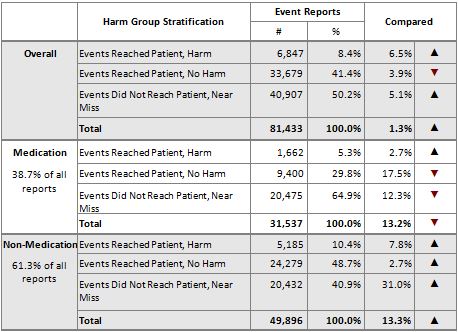All facilities in the Military Health System (MHS) Direct CareDirect care refers to military hospitals and clinics, also known as “military treatment facilities” and “MTFs.”direct care system voluntarily report their patient safety events to the Patient Safety Program. Reporting is one of the key components in the MHS' effort to achieve high reliability, continuously improve and provide the safest patient care possible. Reported events include all degrees of harm for those that reach the patient. Reported events also include near misses and unsafe conditions which do not reach the patient. The reporting of events not reaching the patient allows the Patient Safety Program to analyze the sequence of events that may potentially lead to errors before they affect patients. The Patient Safety Program, through the Patient Safety Analysis Center analyzes the reported data along with additional data sources and provides cumulative data reports and feedback to the military treatment facilities (MTFs) through the Services. These analyses are then utilized to design and develop programs and tools to assist the MTFs in reducing preventable harm and improve safety throughout the direct care system. In contrast to other health care systems, the dental program is an integral component of our health care system and dental events are included in our reporting and analysis in addition to medical events.
The table below shows patient safety reporting in FY 2014, as compared with FY 2013, stratified by harm classification.

You also may be interested in...
Showing results 1 - 15
Page 1 of 2
Article
8/1/2016

Welcome to the August edition of the DoD PSP Treasure Chest! Each and every month, we will be sharing resources to help you execute your day-to-day patient safety activities easily and effectively. Please visit us often and get access to tools and information developed with you, our committed MHS patient safety champions, in mind! This month we highlight the following resources: Patient Activation Resource Guide, Ask Me 3® Brochure, On-Demand e-Learning Courses, and Facebook Page.
Recommended Content:
Patient Safety, eBulletin, Products & Services, Patient Safety Event Reporting, Patient Safety & Quality Academic Collaborative, Advancement toward High Reliability in Healthcare Awards Program
Training Material
7/14/2016
The Leadership Engagement Toolkit was designed to help healthcare leaders assess gaps in their safety culture, engage key influencers for change, set goals for targeted improvement, implement proven safe practices, and reinforce key behaviors to ensure high-reliability performance for improvement. There are two sets of evidence-based best practices (“strategies”): Executive Leadership and Frontline Physician Leadership. The practices focus on what the practice is, why it is used, and how to implement it. There is also a "How to Guide" that focuses on getting started, equipping leaders as coaches, and making and measuring progress.
Recommended Content:
Patient Safety, eBulletin, Products & Services, Patient Safety Program Toolkits & Guides, Patient Safety Event Reporting, Advancement toward High Reliability in Healthcare Awards Program
Article
7/1/2016

The 10th Annual National TeamSTEPPS Conference – an event designed to highlight strategies and techniques to effectively implement and sustain TeamSTEPPS in today’s ever-evolving health care environment – was held 7-10 June, 2016 in Washington, D.C. Welcoming over 700 health care industry professionals and experts, the National TeamSTEPPS conference spotlighted the value of TeamSTEPPS across clinical and non-clinical settings both in the civilian and military space. Addressing a wide range of topics – with over 30 presentations and workshops on subjects ranging from “TeamSTEPPS 101” to “TeamSTEPPS: The Vehicle to Drive your Metrics in the Right Direction,” “The Answer is in the Room: Using TeamSTEPPS to Problem Solve and Reinvigorate Struggling Teams” and “TeamSTEPPS in Times of Transformational Change” – the 2016 TeamSTEPPS National Conference provided attendees the ability to delve into the TeamSTEPPS framework and its application into all aspects of health care and patient safety.
Recommended Content:
Patient Safety, eBulletin, Products & Services, Patient Safety Event Reporting, Patient Safety & Quality Academic Collaborative, Advancement toward High Reliability in Healthcare Awards Program
Article
7/1/2016

Welcome to the July edition of the DoD PSP Treasure Chest! This month, we highlight the SBAR toolkit, the Medical Team Performance Assessment (MTPAT) tool, the Patient Safety Learning Center (PSLC) and the Patient Safety Reporting (PSR) eLearning course. Each and every month, we will be sharing resources to help you execute your day-to-day patient safety activities easily and effectively. Please visit us often and get access to tools and information developed with you, our committed MHS patient safety champions, in mind!
Recommended Content:
Patient Safety, eBulletin, Products & Services, Patient Safety Event Reporting, Patient Safety & Quality Academic Collaborative, Advancement toward High Reliability in Healthcare Awards Program
Article
7/1/2016

Offering various ready-to-use tools, materials and resources, TeamSTEPPS can be tailored to address the specific needs of an organization to seamlessly incorporate its principles into all areas of a health care system. In fact, it is only by fully integrating the tools that TeamSTEPPS offers into our day-to-day activities that Military Health System (MHS) leadership, frontline staff and patient safety professionals will truly benefit from leveraging this methodology. A great example of this is the work and research that the U.S Army Medical Command (MEDCOM) conducted regarding the TeamSTEPPS Teamwork Perceptions Questionnaire (T-TPQ). Highlights of this work were presented at the 2016 National TeamSTEPPS conference this past June.
Recommended Content:
Patient Safety, eBulletin, Products & Services, Patient Safety Event Reporting, Patient Safety & Quality Academic Collaborative, Advancement toward High Reliability in Healthcare Awards Program
Showing results 1 - 15
Page 1 of 2